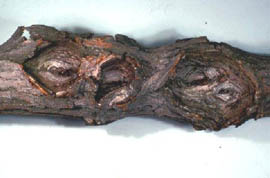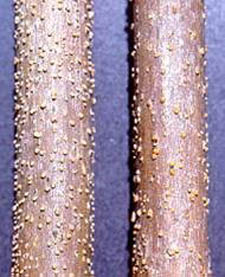Cankers and Fruiting Bodies | |
|---|---|
| October 17, 2006 | |
Branches that have been infected by opportunistic fungi often form cankers. These appear as dead areas on a branch, or areas that are sunken, off color, or bumpy. The image shows cankers on oak associated with the Nectria fungus. The wood under these cankered areas is dead, as you can readily see by peeling back small sections of bark and looking at the color of underlying wood. Healthy wood is white, tan, or green, while dead wood is usually brown. The natural inclination is to remove these dead areas. This prevents wood rot fungi from entering the dead wood and moving into larger branches or trunk tissue. Now is a good time to do that pruning because it is easy to determine which sections of wood are alive and which are dead. As soon as leaves drop, this distinction becomes more difficult. The cause of the cankers is a “chicken and egg” discussion. The fungi that are found in cankers are usually known as stress pathogens. They do not harm the tree or shrub until the plant is stressed. Does the stress cause the canker, or does the fungus cause the canker, and which came first? Canker fungi have been shown to be present in some trees without causing a problem until the tree is stressed. One thing is clear: The use of fungicides does not help in canker management. Remove dead wood and then try to identify and correct the source of stress, but don’t apply fungicides to eradicate the cankers. Some stress factors might include water imbalance, root compaction, root injury, chemical damage, girdling roots, trunk damage, or root rot. Some of these problems can be corrected, and some cannot. If you have ever heard a plant pathologist talk about plant diseases, you have likely heard about fruiting bodies. What are these oddly named things? And what significance do they have to the job of someone working with plants? Understanding fruiting bodies is not as complicated as some might lead you to believe. A plant pathogen is an agent that causes disease. Common infectious agents of plant disease include fungi, bacteria, viruses, and nematodes. Phytoplasmas (such as yellows diseases) might also be added to the list. Of all the plant diseases that we might see in the landscape, only those caused by fungal pathogens have the ability to form fruiting bodies. How do we identify the cause of a fungal disease such as Sphaeropsis blight of pine, Rhizosphaera needle cast of spruce, or perhaps Armillaria root rot? Symptoms are extremely important in such diagnoses, but the characteristics of the fungus itself provide a positive identification. Mycelium is the vegetative part of the fungus, composed of threadlike hyphae. The mycelium is the nutrient-gathering portion of a fungus. A fruiting body is a reproductive structure that produces spores. “Sporocarp” is another general name for a fruiting body. “Carp” is from the Greek “karpos,” which means fruit. Other synonyms include fruit-body, fructification, or sporophore. Fungal fruiting bodies are distinct in size, shape, and color, and type of spores contained, making them very helpful in plant disease diagnosis. Keep in mind that a fruiting body is only the spore-producing portion of the fungus. Where there is a fruiting body, there is also mycelium of that fungus somewhere in the infected plant tissue. As an example, a tree may have a shelf fungus growing from the trunk. This is a fruiting body. Its presence indicates that the tree is also infested with mycelium of this fungus. Simply removing the fruiting body does not remove all the fungus. The presence of fruiting bodies is used as a confirmation of a disease problem. Getting back to those cankers in the wood, if you see fruiting bodies in or on the wood, you know it is infected with a fungus. That is the tissue you want to remove. The oak branch sections in this image are bumpy due to the fruiting bodies of the Tubercularia fungus popping through the bark. The mycelium is inside the bark or wood.  To get all of the infected tissue, including the mycelium that may not be as obvious, remove a few inches of wood beyond the cankered wood. The internal wood that remains should be white, tan, or green. For more information on cankers and wood rots of trees, visit the Extension Vista Web site at http://www.ag.uiuc.edu/%7Evista/horticul.htm and scroll down to “Canker and Dieback Diseases of Woody Plants,” Report on Plant Disease (RPD) no. 636; and “Wood Rots and Decays,” RPD, no. 642. |